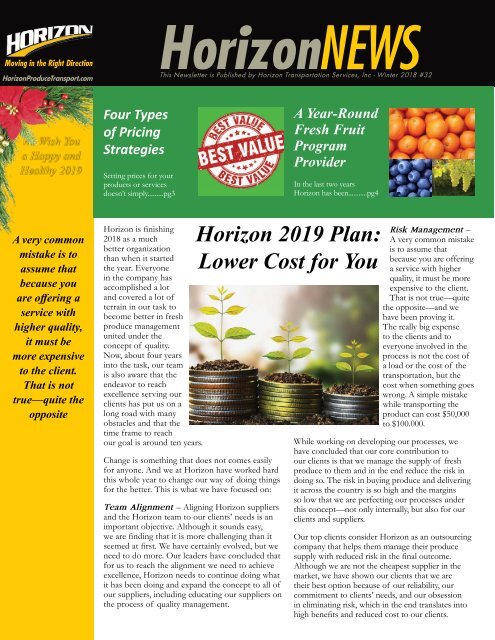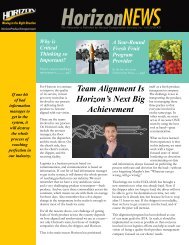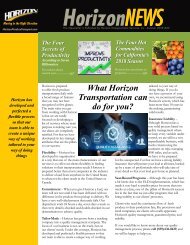Winter 2018
Create successful ePaper yourself
Turn your PDF publications into a flip-book with our unique Google optimized e-Paper software.
Moving in the Right Direction<br />
HorizonProduceTransport.com<br />
HorizonNEWS<br />
This Newsletter is Published by Horizon Transportation Services, Inc - <strong>Winter</strong> <strong>2018</strong> #32<br />
We Wish You<br />
a Happy and<br />
Healthy 2019<br />
Four Types<br />
of Pricing<br />
Strategies<br />
Setting prices for your<br />
products or services<br />
doesn’t simply.........pg3<br />
A Year-Round<br />
Fresh Fruit<br />
Program<br />
Provider<br />
In the last two years<br />
Horizon has been...........pg4<br />
A very common<br />
mistake is to<br />
assume that<br />
because you<br />
are offering a<br />
service with<br />
higher quality,<br />
it must be<br />
more expensive<br />
to the client.<br />
That is not<br />
true—quite the<br />
opposite<br />
Horizon is finishing<br />
<strong>2018</strong> as a much<br />
better organization<br />
than when it started<br />
the year. Everyone<br />
in the company has<br />
accomplished a lot<br />
and covered a lot of<br />
terrain in our task to<br />
become better in fresh<br />
produce management<br />
united under the<br />
concept of quality.<br />
Now, about four years<br />
into the task, our team<br />
is also aware that the<br />
endeavor to reach<br />
excellence serving our<br />
clients has put us on a<br />
long road with many<br />
obstacles and that the<br />
time frame to reach<br />
our goal is around ten years.<br />
Change is something that does not comes easily<br />
for anyone. And we at Horizon have worked hard<br />
this whole year to change our way of doing things<br />
for the better. This is what we have focused on:<br />
Team Alignment – Aligning Horizon suppliers<br />
and the Horizon team to our clients’ needs is an<br />
important objective. Although it sounds easy,<br />
we are finding that it is more challenging than it<br />
seemed at first. We have certainly evolved, but we<br />
need to do more. Our leaders have concluded that<br />
for us to reach the alignment we need to achieve<br />
excellence, Horizon needs to continue doing what<br />
it has been doing and expand the concept to all of<br />
our suppliers, including educating our suppliers on<br />
the process of quality management.<br />
Horizon 2019 Plan:<br />
Lower Cost for You<br />
Risk Management –<br />
A very common mistake<br />
is to assume that<br />
because you are offering<br />
a service with higher<br />
quality, it must be more<br />
expensive to the client.<br />
That is not true—quite<br />
the opposite—and we<br />
have been proving it.<br />
The really big expense<br />
to the clients and to<br />
everyone involved in the<br />
process is not the cost of<br />
a load or the cost of the<br />
transportation, but the<br />
cost when something goes<br />
wrong. A simple mistake<br />
while transporting the<br />
product can cost $50,000<br />
to $100.000.<br />
While working on developing our processes, we<br />
have concluded that our core contribution to<br />
our clients is that we manage the supply of fresh<br />
produce to them and in the end reduce the risk in<br />
doing so. The risk in buying produce and delivering<br />
it across the country is so high and the margins<br />
so low that we are perfecting our processes under<br />
this concept—not only internally, but also for our<br />
clients and suppliers.<br />
Our top clients consider Horizon as an outsourcing<br />
company that helps them manage their produce<br />
supply with reduced risk in the final outcome.<br />
Although we are not the cheapest supplier in the<br />
market, we have shown our clients that we are<br />
their best option because of our reliability, our<br />
commitment to clients’ needs, and our obsession<br />
in eliminating risk, which in the end translates into<br />
high benefits and reduced cost to our clients.
Moving in the Right Direction<br />
HorizonNEWS<br />
If the<br />
organization<br />
has a flawed<br />
design, it<br />
simply won’t<br />
perform well<br />
The 3 Elements<br />
of Organizational<br />
Structure & Design.<br />
If I were to ask you a random and seemingly<br />
strange question, “Why does a rocket behave<br />
the way it does and how is it different from a<br />
parachute that behaves the way it does?” You’d<br />
probably say something like, “Well, duh, they’re<br />
designed differently. One is designed to go fast<br />
and far and the other is<br />
designed to cause drag and<br />
slow an object in motion.<br />
Because they’re designed<br />
differently, they behave<br />
differently.” And you’d be<br />
correct. How something is<br />
designed controls how it<br />
behaves. (If you doubt this,<br />
just try attaching an engine<br />
directly to a parachute and<br />
see what happens).<br />
But if I were to ask you<br />
a similar question about<br />
your business, “Why does<br />
your business behave<br />
the way it does and how<br />
can you make it behave<br />
differently?” would you<br />
answer “design?” Very<br />
few people — even<br />
management experts —<br />
would. But the fact is<br />
that how your organization<br />
is designed determines<br />
how it performs. If you want to improve<br />
organizational performance, you’ll need to change<br />
the organizational design. And the heart of<br />
organizational design is its structure.<br />
There’s a saying in architecture and design that<br />
“form follows function.” Put another way, the<br />
design of something should support its purpose.<br />
For example, take a minute and observe the<br />
environment you’re sitting in (the room, building,<br />
vehicle, etc.) as well as the objects in it (the<br />
computer, phone, chair, books, coffee mug, and<br />
so on). Notice how everything serves a particular<br />
purpose. The purpose of a chair is to support a<br />
sitting human being, which is why it’s designed the<br />
way it is. Great design means that something is<br />
structured in such a way that it allows it to serve<br />
its purpose very well. All of its parts are of the<br />
right type and placed exactly where they should<br />
be for their intended purpose. Poor design is just<br />
the opposite. Like a chair with an uncomfortable<br />
seat or an oddly measured leg, a poorly designed<br />
object just doesn’t perform like you want it to.<br />
Even though your organization is a complex<br />
adaptive system and not static object, the same<br />
principles hold true. If the organization has a<br />
flawed design, it simply won’t perform well. It<br />
must be structured (or restructured) to create<br />
an design that supports its function or business<br />
strategy. Just like a chair, all of its parts or<br />
functions must be of the<br />
right type and placed in the<br />
right location so that the<br />
entire system works well<br />
together. What actually gives<br />
an organization its “shape”<br />
and controls how it performs<br />
are three things:<br />
1- The functions it<br />
performs.<br />
2- The location of each<br />
function.<br />
3- The authority of each<br />
function within its domain.<br />
The functions an<br />
organization performs are<br />
the core areas or activities<br />
it must engage in to<br />
accomplish its strategy (e.g.<br />
sales, customer service,<br />
marketing, accounting,<br />
finance, operations, CEO,<br />
admin, HR, legal, PR, R&D, engineering, etc.).<br />
The location of each function is where it is<br />
placed in the organizational structure and how it<br />
interacts with other functions. The authority of<br />
a function refers to its ability to make decisions<br />
within its domain and to perform its activities<br />
without unnecessary encumbrance. A sound<br />
organizational structure will make it unarguably<br />
clear what each function (and ultimately each<br />
person) is accountable for. In addition, the design<br />
must both support the current business strategy<br />
and allow the organization to adapt to changing<br />
market conditions and customer needs over time.<br />
Source: Lex Sisney, the creator of Organizational Physics<br />
Examine<br />
your pricing<br />
objectives<br />
to develop<br />
a clear idea<br />
of what<br />
you want<br />
your pricing<br />
strategy to<br />
achieve.<br />
HorizonNEWS<br />
Four Types of<br />
Pricing Strategies<br />
Setting prices for your products or services<br />
doesn't simply come down to a simple<br />
calculation. Prices can be practical tools for<br />
making ends meet or they can be marketing<br />
tactics for communicating something about<br />
the quality of your offerings. To figure out the<br />
best way to set prices, it's worthwhile to take a<br />
step back and examine your pricing objectives<br />
to develop a clear idea of what you want your<br />
pricing strategy to achieve.<br />
Profit-Oriented Pricing<br />
In a sense, all pricing is<br />
profit-oriented because,<br />
even if you set prices<br />
with other objectives<br />
in mind, you still need<br />
to earn a profit to stay<br />
in business. However,<br />
profit-oriented pricing<br />
makes profit the top<br />
priority when figuring<br />
out the ideal price to<br />
set. A profit-oriented<br />
pricing strategy looks<br />
for the sweet spot that<br />
allows you to charge<br />
as much as possible<br />
for your offerings without charging so much<br />
that you alienate potential customers and lose<br />
money through missed sales. This type of<br />
pricing objective can either aim to maximize<br />
profit per unit relative to cost of goods sold<br />
and other operating costs, or it can aim to<br />
maximize overall profit by setting a price that<br />
is competitive enough to increase the overall<br />
number of units you sell.<br />
Competitor-Based Pricing<br />
Competitor-based pricing uses the price you<br />
set to appeal to customers and define your<br />
niche relative to your competitors. It doesn't<br />
necessarily rely on setting a lower price than<br />
other available options, although this strategy<br />
will certainly make your products appeal to<br />
customers who shop on the basis of price alone.<br />
You can also use competitor-based pricing<br />
effectively by setting a price that's in the same<br />
ballpark as other products in the same niche, or<br />
by choosing a higher price to send the message<br />
that your product is superior and worth the<br />
extra money.<br />
Market Penetration<br />
A market penetration pricing strategy is geared<br />
towards getting a foothold in a competitive<br />
market, usually by offering a low initial price.<br />
If you start out by attracting customers on<br />
the basis of price, you can get more people<br />
to try your products, and then start building a<br />
reputation and clientele that will allow you to<br />
eventually charge more.<br />
A market penetration<br />
strategy can be risky<br />
because customers don't<br />
like growing accustomed<br />
to a low price and then<br />
being asked to pay more.<br />
However, this approach<br />
can be successful if your<br />
products really do have<br />
qualities other than price<br />
that will make customers<br />
want to buy them, such<br />
as unique features or<br />
unusually high quality.<br />
Skimming<br />
A skimming pricing strategy uses the opposite<br />
logic from one based on market penetration.<br />
Although market penetration uses low prices<br />
to attract attention, skimming uses a reputation<br />
that has already been built to charge high prices<br />
from early adopters. If customers are passionate<br />
about your products and willing to pay extra to<br />
be the first to have them, you can charge initial<br />
high prices when you first introduce a new<br />
innovation or a new line, and then lower the<br />
prices once you've already attracted the people<br />
who are willing to pay more.<br />
Source: Devra Gartenstein<br />
HorizonNews is published by Horizon Transportation issued every quarter to improve communication in the Produce Industry.<br />
Publisher: Thomas Leal Design: Business Spring Communications - www.b-spring.com, tel (559) 801 2090
A Year-Round Fresh Fruit<br />
Program Provider<br />
HorizonNEWS<br />
In the last two years, Horizon has been gradually consolidating its long<br />
plan vision of being a Fresh Fruit Program Supplier to the retail and<br />
food service industry- mainly for Grapes, Citrus, Stone fruit and Berries.<br />
Horizon has reached this objective by enforcing that everyone of their<br />
partners and suppliers apply the concept of continuous improvement to<br />
the process of fresh fruit management and logistics.<br />
This process has resulted in the accomplishment of three main<br />
achievements:<br />
1 - The creation of a group of partners that are willing to<br />
participate and evolve continuously within Horizon program and vision.<br />
2 - The development of a team of managers trained and<br />
focused on the client wants and needs.<br />
3 - The implementation of food safety standards, and best<br />
practices to everyone involved in our process: from farmers and<br />
handlers to shippers and logistics.<br />
Fresh Seedless Grapes for Schools<br />
®<br />
Horizon most successful program, so<br />
far, has been Sweet Bunches - a fresh<br />
portioned seedless grapes, designed<br />
for schools around the country: a<br />
snack for children with an average of<br />
twelve berries each, that still carries the freshness of the farms. Sweet<br />
Bunches success is due to a rigid quality control on food safety and<br />
best practices that each one of Horizon’s partners must obey to be part<br />
of such program.<br />
Fresh Portioned Seedless Grapes<br />
®<br />
The school year has just begun, and food-service companies and<br />
schools have realized the depth of Horizon program, and are asking<br />
for Sweet Bunches for their students. Horizon has been doing its best<br />
to fulfill their needs, though we are limited by the supplier’s capacity.<br />
If you would like to learn more about Horizon Programs and find out<br />
how you can benefit from our fresh fruit supply chain, call (559) 636<br />
0429 or link to horizonproduce.com. Be part of this team where<br />
everyone is united by a quality process—a process of getting<br />
fresh fruit to your table all year-round.<br />
A Fresh Fruit Supplier




